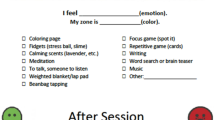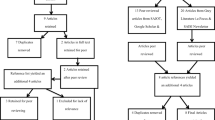Abstract
There is a compelling need for varied “trauma specific” treatment models for children and adolescents with complex trauma in residential treatment whose affect and behavioral dysregulation disrupts daily living and impedes treatment engagement. This conceptual paper introduces exploratory applications of sensory motor approaches to the treatment of affect and behavioral dysregulation. Sensory Integration, a specialization within occupational therapy (Ayres 1972, 2004) provides knowledge of the sensory motor systems and strategies for sensory modulation that addresses arousal regulation, which underlies this dysregulation. The article describes three clinically supported approaches to the use of sensory modulation in residential treatment sites: use of sensory rooms; use of sensory integration occupational therapists at residential treatment sites; and a trauma psychotherapy that utilizes sensory motor strategies to improve regulation and support trauma processing.
Similar content being viewed by others
References
Ayres, A. J. (1972). Sensory integration and learning disorders. Los Angeles: Western Psychological Services.
Ayres, A. J. (2004). Sensory integration and the child (2nd ed.). Los Angeles: Western Psychological Services.
Bell, C. C., & McBride, D. F. (2010). Affect regulation and the prevention of risky behaviors. Journal of American Medical Association, 304(5), 565–566.
Blaustein, M., & Kinniburgh, K. (2010). Treating traumatic stress in children and adolescents; How to foster resilience through attachment, self-regulation, and competency. New York: Guilford Press.
Boyer, S. N., Hallion, L. S., Hammell, C. L., & Button, S. (2009). Trauma as a predictive indicator of clinical outcome in residential treatment. Residential Treatment for Children & Youth, 26, 92–104.
Brady, K. L., & Caraway, S. J. (2002). Home away from home: factors associated with current functioning in children living in a residential treatment setting. Child Abuse & Neglect, 26, 1149–1163.
Briggs, E. C., Greeson, J. K., Layne, C. M., Fairbank, J. A., Knoverek, M. S., & Pynoos, R. S. (2012). Trauma exposure, psychosocial functioning, and treatment needs of youth in residential treatment care: preliminary findings from the NCTSN core data set. Journal of Child & Adolescent Trauma, 5(1), 1–15. doi:10.1080/19361521.2012.646413.
Brown, C., & Dunn, W. (2002). Adolescent/adults sensory profile. San Antonio: The Psychological Corporation.
Brown, A.D., McCauley, K., Navalta, C.P., & Saxe, G.N. (2013). Trauma systems therapy in residential settings: improving emotion regulation and the social environment of traumatized children and youth in congregate care. Journal of Family Violence, 27(8). doi:10.1007/s10896-013-9542-9.
Champagne, T. (2003a). Creating nurturing environments and a culture of care. Advance for Occupational Therapy, 19(19), 50.
Champagne, T. (2003b). Sensory modulation & environment: Essential elements of environment. Southampton: Champagne Conferences & Consultation.
Champagne, T. (2006). Creating sensory rooms: essential enhancements for acute inpatient mental health settings. Mental Health Special Interest Section Quarterly, 29, 1–4.
Champagne, T. (2007). Physical environment. In The Massachusetts Department of Mental Health, developing positive cultures of care: Resource guide. Boston: Massachusetts Department of Mental Health.
Champagne, T. (2008). Sensory modulation and environment: Essential elements of occupation (3rd ed.). Southampton: Champagne Conferences & Consultation.
Champagne, T. (2010a). Sensory modulation and environment: Essential elements of occupation (3rd ed.). Australia: Pearson Assessment.
Champagne, T. (2010b). Occupational therapy in high-risk and special situations. In M. Scheinholtz (Ed.), Occupational therapy in mental health: Considerations for advanced practice (pp. 179–197). Bethesda: American Occupational Therapy Association.
Champagne, T., & Stromberg, N. (2004). Sensory approaches in inpatient psychiatric settings: innovative alternatives to seclusion and restraint. Journal of Psychosocial Nursing, 42, 35–44.
Champagne, T., & Tewfik, D. (2010). Trauma, mental health care & occupational therapy practice. In M. Scheinholtz (Ed.), Occupational therapy in mental health: Considerations for advanced practice (pp. 215–230). Bethesda: American Occupational Therapy Association.
Cheng, M., & Boggett-Carsjens, J. (2005). Consider sensory processing disorders in the explosive child: case report and review. The Canadian Child and Adolescent Psychiatry Review, 14(2), 44–48.
Commonwealth of Massachusetts. (2006). Department of mental health regulations: Prevention of restraint and seclusion and requirements when used (104 CMR 27.12 (1)(e)). Boston: Commonwealth of Massachusetts.
Conklin, C. Z., Bradley, R., & Westen, D. (2006). Affect regulation in borderline personality disorder. Journal of Nervous and Mental Disease, 194(2), 60–77.
Cook, A., Blaustein, M., Spinazzola, J., & van der Kolk, B. (2003). Complex trauma in children and adolescents: White Paper from the National Child Traumatic Stress Network Complex Trauma Task Force. Durham: National Child Traumatic Stress Network.
Cook, A., Spinazzola, J., Ford, J., Lanktree, C., Blaustein, M., Cloitre, M., et al. (2005). Complex trauma in children and adolescents. Psychiatric Annals, 35(5), 390–398.
Department of Mental Health of Massachusetts (DMH-MA) (2000). Retrieved from: http://www.mass.gov/eohhs/gov/departments/dmh/restraintseclusion-reduction-initiative.html
Diamond, A. (2002). Normal development of prefrontal cortex from birth to young adulthood: Cognitive functions, anatomy, and biochemistry. In D. T. Stuss & R. T. Knight (Eds.), Principles of frontal lobe function (pp. 466–503). New York: Oxford University Press.
Diamond, A. (2006). The early development of executive functions. In E. Bialystok & F. I. Craik (Eds.), Lifespan cognition: Mechanisms of change (pp. 70–95). New York: Oxford Univ. Press.
Ford, J.D., & Blaustein, M.E. (2013). Systemic self-regulation: a framework for trauma-informed services in residential juvenile justice programs. Journal of Family Violence, 27(8). doi:10.1007/s10896-013-9538-5.
Ford, J. D., & Hawke, J. (2012). Trauma affect regulation psychoeducation group and milieu intervention outcomes in juvenile detention facilities. Journal of Aggression, Maltreatment & Trauma, 21, 365–384.
Gross, J. J. (Ed.). (2007). Handbook of emotion regulation. New York: Guilford Press.
Habib, M., Labruna, V., & Newman, J. (2013). Complex histories and complex presentations: implementation of a manually-guided group treatment for traumatized adolescents. Journal of Family Violence, 27(8). doi:10.1007/s10896-013-9532-y.
Hodgdon, H., Kinniburgh, K., Gabowitz, D., Blaustein, M., & Spinazzola, J. (2013). Development and implementation of trauma-informed programming in residential schools using the ARC framework. Journal of Family Violence, 27(8).
Jenkins, H.S. (2008). Gibson’s “affordances”: evolution of a pivotal concept. Journal of Scientific Psychology, (34–45).
Kagan, R., & Spinazzola, J. (2013). Real life heroes in residential treatment: implementation of an integrated model of trauma and resiliency-focused treatment for children and adolescents with complex PTSD. Journal of Family Violence, 27(8). doi:10.1007/s10896-013-9537-6.
Kaiser, E. M., Gillette, C., & Spinazzola, J. (2010). A controlled pilot-outcome study of sensory integration (SI) in the treatment of complex adaptation to traumatic stress. Journal of Aggression, Maltreatment and Trauma, 19(7), 699–720.
Knoverek, A.M., Briggs, E.C., Underwood, L.A., & Hartman, R.L. (2013). Clinical considerations for the treatment of latency age children in residential care. Journal of Family Violence, 27(8). doi:10.1007/s10896-013-9536-7.
Koomar, J. A., & Bundy, A. C. (2002). Creating direct intervention from theory. In A. C. Bundy, S. J. Lane, & E. A. Murray (Eds.), Sensory integration: Theory and practice (2nd ed., pp. 261–308). Philadelphia: F. A. Davis.
LeBel, J. (2006). Seclusion & restraint – rediscovering pathways to compassionate care. American Academy of Child & Adolescent Psychiatry (AACAP News) Retrieved http://www.aacap.org/cs/root/member_information/practice_information/jan/feb_2006_aacap_news.
LeBel, J., & Champagne, T. (2010). Integrating sensory and trauma-informed interventions, A Massachusetts state initiative, part 2. Mental Health Special Interest Section Quarterly, 33(2), 1–4.
LeBel, J., Champagne, T., Stromberg, N., & Coyle, R. (2010). Integrating sensory and trauma-informed interventions: a Massachusetts state initiative, part 1. Mental Health Special Interest Section Quarterly, 33(1), 1–4.
Miller, A., & Miller, E. (1989). From ritual to repertoire: A cognitive-developmental systems approach with behavior-disordered children. New York: John Wiley & Sons.
Miller, L. J., & Summers, C. (2001). Clinical applications in sensory modulation dysfunction: Assessment and intervention considerations. In S. S. Roley, E. J. Blanche, & R. C. Schaafs (Eds.), Understanding the nature of sensory integration in diverse populations (pp. 247–274). San Antonio: Therapy Skill Builders.
National Association of State Mental Health Program Directors. (2003). National Executive Training Institute: Training curriculum for the reduction of seclusion and restraint. Alexandria: National Association of State Mental Health Program Directors.
Schore, A. (2003). Affect dysregulation and disorders of the self. New York: WW Norton & Co.
Steele, H., & Steele, M. (2005). Understanding and resolving emotional conflict: The London parent–child project. In K. Grossman, K. Grossman, & E. Waters (Eds.), Attachment from infancy to adulthood: The major longitudinal studies (pp. 137–164). NY: Guildford Press.
Terr, L. (1991). Childhood traumas: an outline and overview. American Journal of Psychiatry, 148(1), 10–20.
U.S. Department of Health and Human Services (USDHHS), Substance Abuse and Mental Health Services Administration. (2003). A national call to action: Eliminating the use of seclusion and restraint. Rockville: USDHHS.
van der Kolk, B. (1994). The body keeps the score: memory and the emerging psychobiology of post traumatic stress. Harvard Review of Psychiatry, 1, 253–265.
van der Kolk, B., & Fisler, R. (1994). Childhood abuse and neglect and loss of self-regulation. Bulletin of the Menninger Clinic, 58(2), 145–168.
Warner, E., Westcott, A., Cook, A., & Koomar, J. A. (2010). In B. van der Kolk Chairperson (Ed.), Attunement and rhythmicity: Treatment in the SMART room. Boston: International Trauma Conference.
Warner, E., Cook, A., Westcott, A., & Koomar, J. (2011). Sensory motor arousal regulation treatment (SMART), A manual for therapists working with children and adolescents: A “bottom up” approach to treatment of complex trauma. Boston: Trauma Center at JRI.
Wilbarger, P. (1995). The sensory diet: activity programs based upon sensory processing theory. Sensory Integration Special Interest Section Quarterly, 18(2), 1–4.
Williams, M. S., & Shellenberger, S. (1994). How does your engine run? A leader’s guide to the alert program for self-regulation. Albuquerque: Therapy Works.
Zelechoski, A.D., Sharma, R., Beserra, K., Miguel, J., DeMarco, M., & Spinazzola, J. (2013). Traumatized youth in residential treatment settings: prevalence, clinical presentation, treatment, and policy implications. Journal of Family Violence, 27(8). doi:10.1007/s10896-013-9534-9.
Author information
Authors and Affiliations
Corresponding author
Additional information
Author Note
Since the writing of the article, Dr. Jane Koomar passed away on February 24, 2013 after a three-year struggle with cancer. Her significant contribution to the SMART model was to collaborate in addressing the problem of regulation for traumatized youth through understanding sensory modulation. However, her contribution to her own field of Sensory Integration Occupational Therapy was her abiding commitment and major professional achievement. The founder of a thriving clinic, now known as OTA The Koomar Center, located in Newton, Massachusetts, she also contributed to the flowering of the field of Sensory Integration through clinical work, teaching, research, collaboration with colleagues across the country, and continual exploration of new ways to bring together the worlds of occupational therapy, mental health, and neuroscience to address questions about sensory processing. She had a special interest in attachment and worked with Dan Hughes, Ph.D. to address the profound effects of loss on the development of the human being.
Rights and permissions
About this article
Cite this article
Warner, E., Koomar, J., Lary, B. et al. Can the Body Change the Score? Application of Sensory Modulation Principles in the Treatment of Traumatized Adolescents in Residential Settings. J Fam Viol 28, 729–738 (2013). https://doi.org/10.1007/s10896-013-9535-8
Published:
Issue Date:
DOI: https://doi.org/10.1007/s10896-013-9535-8




